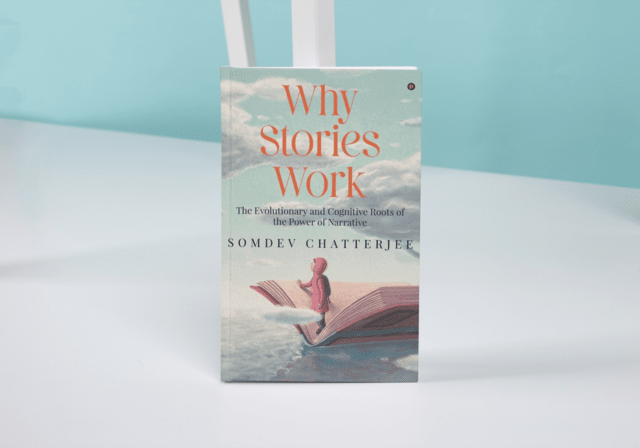While majority of the books in popular arena today are written and read for the purpose of entertainment, books have for a long time been the primary medium for us to capture our thoughts, pass on our knowledge and share it with readers who also have interest in such matters. We peruse such books and sometimes share our reviews on the books we find interesting and here are some quick links to reviews of collections of essays and other works of non-fiction:
- Essays on the Indic History by Vijender Sharma
- Suvarna Mohur – India’s Glorious History illustrated through Rare Coins by Arun Ramamurthy
- A Short History of Nearly Everything by Bill Bryson
Recently we received a copy of Why Stories Work by author Somdev Chatterjee, who is a writer, filmmaker and teacher. With this book, he brings to readers a narrative on the power of stories and humanity’s long-standing relationship with the art of telling tales.
| Book Title | : | Why Stories Work The Evolutionary and Cognitive Roots of the Power of Narrative |
| Author | : | Somdev Chatterjee |
| Published by | : | Notion Press |
| # of Pages | : | 106 (Paperback) |
| # of Chapters | : | 4 |
| Purchase Link(s) | : |
This Is Here In For You
Book Cover:
Let us take a look at the cover page of this book.

Why Stories Work by Somdev Chatterjee | Book Cover
As you can see, the cover page of – Why Stories Work – is designed with an aspiration theme featuring serene blue sky with powder puff clouds and a young child about to leap off the pages of a book into the limitless ocean.
It is simple yet impactful. It is possible that it may not catch your attention amongst a set of books in the display. but, it is faithful to the content for sure. A very thoughtful and attractive cover page.
The Book And Our Views For The Same:
Usually, we talk about a book in two distinguished segments, focused on the story and our views for the same, respectively. But for books like this, we merge both these segments here.
At the very beginning, the author tells us about his conversations with students of cinemaking arts and their ambivalence regarding a need for a solid story. In a way, these conversations served as an inspiration for the author in telling the story about story-telling.
The book is constructed with four chapters progressively building the full picture with each chapter highlighting a particular aspect of storytelling, while also building on the previous chapter.
Chapter 1: Tell it like your life depends on it.
How stories have kept us alive as a species – and how they can kill us. The author shares some of the contemporary research about short term memory that has lead to some interesting observations around how our limited brain space is organised. As humanity discovered languages and the art of communicating effectively in the early days of our shared existence that differentiated us from primates, such changes shaped our communities. As it happens, we learned to share our experiences through stories told around the groups and also learned to share plans for survival this way. As such, thinking of storytelling as a form of art that developed out of leisure time is arguable.
Chapter 2 – Learning to inhabit unreal worlds
In this chapter, the author explains to us how stories have allowed us to develop our imagination, to build up scenarios and chain of events that are not taking place in your real life at that time – as if they were real. Even in the modern forms like a movie, a tv series, a book or a newspaper article – you can bring to mind an instance of how much emotionally invested people can be about these stories and what happens to the characters in these stories. The author brings to us observations from research that argues that adults experiencing such a story is similar to how children learn to experience the grown-up world through playing with dolls and toys, sometimes rough and tumble play with other children. Because your brain knows it is not real, there is an element of enjoyment in these type of learning, in teaching yourself what you can do – apart from freeze, flee or fight, because not all threats in today’s world are physical.

Why Stories Work by Somdev Chatterjee | Book Cover
Chapter 3 – Maps of experienced reality
While the art of story telling may have been born as part of survival of our ancestors living around firelight, it has come a long way with us to today’s modern era. As we have continued to mould our surroundings to protect us, built our habitats to comfort us and created a world with technology at our fingertips to bathe us in convenience and luxury that is powered by centuries of inventions. This is where the limitations of our brains in terms of comprehending the nitty-gritty of 100% of our surroundings falls deceivingly short. We are required to keep up with the constant changes in the way we live, we work, we communicate and we socialise. Once again, it is through stories that we practice this.
The author reminds us that the central theme of so many of the stories that have existed in almost every culture, all around the world, appears to run on the same pattern. There is usually a protagonist, who has to go out of his comfort zone, face a dragon (or equally scary monster), and find ways to win that they can share with their family and friends. If you think about it, the monster may have changed from scary beasts like dragons to machines and robots of science fictions, but humanity continues to survive those….
Chapter 4 – How Stories Work
In this chapter, the author shows us how not only we have made stories essential part of our lives, we have also learn to shape them so that we get most out of it. We recognise that our limited brain power is usually spent on processing the information from the world around us that is affecting us directly. . Most of the time, our brain is only taking a part of the information in from our surroundings and feeling in the rest to process it into a version that humans feel comfortable to deal with. In the same way, we also try to use stories as a means of explanation, e.g., we try to write history so that it feels like a chain of events rationally linked together showing cause and effect relationships. While in reality, it may just have been a jumble of random events. We like our stories to have logical, happy endings with a moral lesson attached to it. And it is these moral lessons that we need to build a society and co-exist together as humanity.
Summary:
A nicely written book that blends research on how human brain works, how humanity has evolved and how we have developed modes of communication to coexist. We enjoyed reading this book that discusses how the art of storytelling has become one of our biggest and most familiar medium that educates, engages, entertains and sometimes can also disrupt our society.
ThinkerViews Rating:
Around 7.5 stars out of 10.
Quick Purchase Links:
- Buy - Why Stories Work by Somdev Chatterjee - Paperback - Amazon IN
- Buy - Why Stories Work by Somdev Chatterjee - Paperback - Amazon US
Over To You:
If you already have read the book do share your remarks and thoughts via comments below. Does this review help you in making your decision to buy or read the book? Do not forget to share this article with your friends over various social networks. Please follow/subscribe us on various Social networks like Twitter, Facebook, YouTube, Spotify, Amazon Prime Music, Audible, and others. And yes, you may like to subscribe to our RSS feeds to get latest updates for the site to land right in your mail box.
 ThinkerViews – Views And Reviews Personal views and reviews for books, magazines, tv serials, movies, websites, technical stuff and more.
ThinkerViews – Views And Reviews Personal views and reviews for books, magazines, tv serials, movies, websites, technical stuff and more.



